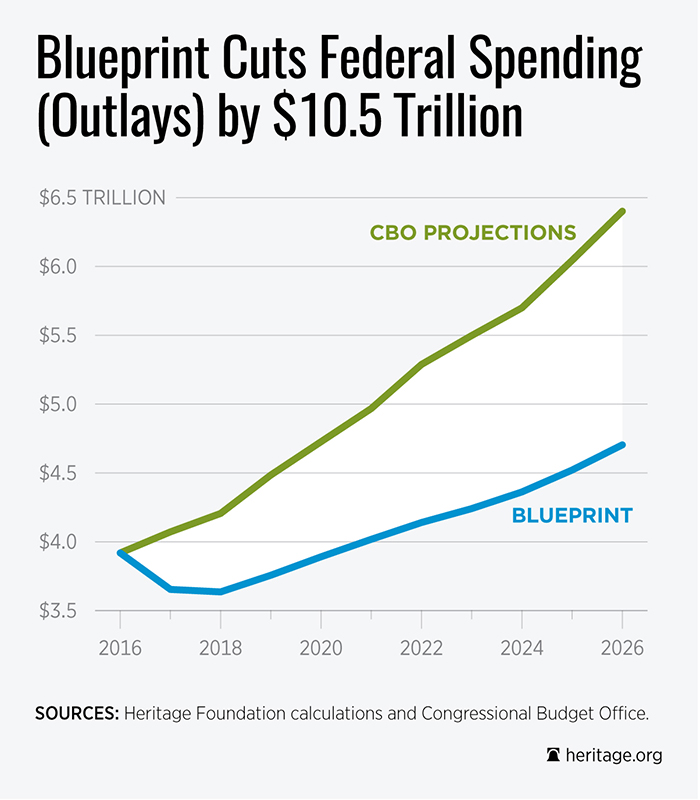Over the next decade, the Congressional Budget Office (CBO) expects total spending (outlays) to rise by almost 5 percent annually, with spending totaling nearly $51.4 trillion over the entire period.
At this rate, spending growth would significantly outpace revenue growth, resulting in more than $9 trillion in cumulative deficits, which would drive debt to devastating levels that could take decades to dig out of. According to CBO, projected levels of deficit and debt are not sustainable and would have negative economic effects.
The solution is clear: It’s time for Congress to adopt a conservative budget.
Over the next decade, the Heritage Blueprint for Balance would cut spending by $10.5 trillion, reduce the national debt, and put the nation back on a prosperous economic course.
>>> To Read the Heritage Foundation’s: A Blueprint for Balance: A Federal Budget for 2017.
Key components of the budget would:
Bring Spending Under Control
The Blueprint for Balance would reduce total spending by $10.5 trillion over the next decade as compared to CBO baseline projections. It reduces the average spending growth rate from the nearly 5-percent annual rate projected by CBO to a more sustainable rate of 1.7 percent annually.
Reduce the National Debt and Reins in Interest Spending
The Heritage budget reduces the national debt by over $9 trillion over the next 10 years. By reducing spending and stabilizing the debt, this budget reins in the cost of servicing the debt, freeing up resources for other national priorities such as defense.
CBO currently estimates that net interest spending will take up a larger share of total outlays than national defense by 2024. The Heritage budget cuts net interest payments by over $1.3 trillion compared to the CBO baseline in the next 10 years.
Reform Entitlement Programs
Entitlement spending is growing on autopilot, consuming more and more of the federal budget each year. Tens of trillions in unfunded obligations are threatening younger generations with massive tax increases and undue burdens of debt.
This blueprint would:
- Repeal Obamacare
- Modernize Medicare by transitioning to a premium-support system and making key reforms to meet demographic, fiscal, and structural challenges
- Cap the federal allotment for Medicaid and give states greater flexibility in designing benefits and administering the program
- Make commonsense reforms to Social Security to ensure seniors and individuals with disabilities are protected from poverty when they are unable to work, while accounting for increased life expectancy and reducing the growth in benefits
Cut Wasteful and Duplicative Programs
The Heritage budget prioritizes non-defense discretionary programs that fall within the powers delegated to Congress by the Constitution, eliminating activities that would be better handled by the private sector or state and local governments. It also identifies and eliminates wasteful and duplicative programs, saving almost $100 billion in the 2017 fiscal year alone.
Enhance Opportunity for All
The Blueprint for Balance gives recommendations for a budget process that provides Congress with a critical opportunity to review federal policy in all areas and to put forth a strong vision for an America that offers opportunity for all with favoritism to none.
Prioritize Defense Spending
The blueprint prioritizes national defense capabilities by taking resources from wasteful and duplicative domestic programs and devoting some of those funds to the federal government’s constitutional role of providing defense. With continued and rising tensions across all corners of the globe, adequately funding national defense must be a top priority.
According to CBO, if the debt level continues to grow at the current rate there will be severe consequences, including higher spending on interest payments when interest rates normalize, lower wages and productivity, less flexibility by lawmakers to use taxing and spending policies in response to unexpected changes, and increased likelihood of a fiscal crisis which would lead to a sudden and sharp increase in interest rates and the federal debt.
Congress must act now to cut spending and curb the growth of debt. Americans cannot afford the alternative.





























